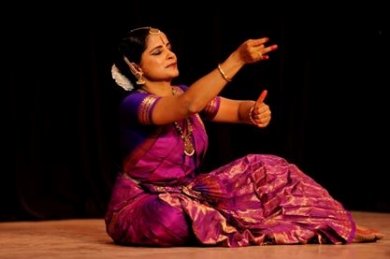
|   |

|   |
Sampradaya - Sumana Shashidhar e-mail: ssumana@stanford.edu December 7, 2015 On Nov 15, 2015 Chennai based Indira Kadambi presented SAMPRADAYA organized by two Bay Area Bharatanatyam exponents Shubha Aithal (RaSa Academy of Performing Arts) and Vidhya Vijaykumar (Ratinam School of Dance), held at Sri Rajarajeshwari Temple in San Jose, CA. Prior to the beginning of the program, Kadambi came on stage, resplendent in royal blue and maroon, to greet the audience. She explained that after a hiatus of nearly 10 years, this performance was her first one, her first step on her ‘maargam’ as she put it! She smiled as she recounted that her last performance prior to her break also had been in the Bay Area, more specifically Santa Cruz. Kadambi explained that she wanted to keep this an informal event and had also chosen her items with great care, not to just give a performance, but to have a moment with the audience, to take a break from the crazy rushing about hustle-bustle lifestyle all of us have adopted as our new normal. The invocation was sung by Sanjana Aithal and Sneha Anantharaman. Kadambi started her performance with alarippu in khanda chaapu. The jathiswaram in raga Saraswati set in rupaka tala began with a small segment of abhinaya based on a poem in which the poet extols the virtues of Goddess Saraswati, before segueing into the nritta item. This was a most unusual composition, creative, evocative, like watching poetry in motion.  The pada varnam ‘Entaninne Telupudura’ in raga Khamas set in tala tisra eka, was in adoration of Lord Thyagaraja Swami. The composition of this dance piece was complex, depicting the carrying of the palanquin in the traditional pattern of the temple, sideward jump followed by a forward and backward motion, and with Lord Thyagaraja Swami striding in front of it with his sword aloft, ready to go to war against Tripura. This pada varnam is also graced with three charanams interspersed with the swaralayas, as the nayika pleads with Lord Thyagaraja Swami to acknowledge and accept her love and make her his forever. This is in stark contrast to the one repeating charanam that most other varnams contain. Kadambi, with her consummate skill, executed this item with utmost grace and ease, her technical poses completing crisply, interspersed with evocative abhinaya of the nayika’s suffering as her Lord strides on by, oblivious to her suffering. At the conclusion of this item, the second half of the program began, featuring the pure abhinaya items. Kadambi opened with devaranama ‘Gummana Kareyadire’ in raga Durga set to adi tala. This composition is based on baby Krishna’s pleas to his mother to please not call the boogeyman, after mother Yashodha, tired of his mischief and complaints from the other women of Vraja, decides to scare him into behaving as she wants him to. Kadambi lived the role as she emoted Krishna telling his mother that he would be the best child ever, eat his food, not ask for breastmilk, just go to the puja room and sit there quiet, not tease the girls, let the calves drink milk from the cows, not eat mud or go swimming in the waters of the River Yamuna to dance with snakes. Kadambi’s last item for this performance was the ashtapadi ‘Pashyati Dishi Dishi’ from the Gita Govindam composed by Jayadeva. In it, Radha, having been promised by Krishna that he will meet her in the evening hour by the river, runs to the location in ecstatic anticipation, only to encounter his absence. Her depiction ranged from Radha’s excitement to bewilderment at Krishna’s non-arrival, to despair and pain… only to have her excitement rekindled as a creeper, a tree, the trill of a bird reminds her of some aspect of Krishna. The audience could not help reacting to Radha’s emotions, feeling her joy and pain as if it were our own! After the performance, the question and answer session ensued. Kadambi patiently answered the questions of the audience, ranging from a young dancer under Shubha Aithal’s tutelage to the general audience. Her message was inspirational. To dancers, she stated that it was not the thrill of a performance or the promise of an arangetram that should be their motivation, but their joy at dancing, no matter where, no matter when, whether there is an audience present or not. To parents, she said that your child learning dance should be organic, not forced. If a child does not enjoy a particular art form, guide them to something else, do not compare them to any other child, and most importantly, instill a love of the fine arts by taking them to quality performances to light the spark of interest. To former dancers like myself, she reminded us that it is never too late to take up an art form, whether for the first time or to restart it after a break, at any age, if that art form is a soul enriching part of us. She encouraged the dancers to be strong and fit, as the rigorous demands of dance are only fulfilled when both body and mind are conditioned. She also urged dancers to learn music, as the symphony between the art of music and dance in a person who has learnt both art forms is exponentially symbiotic in the increased beauty of both performances. |